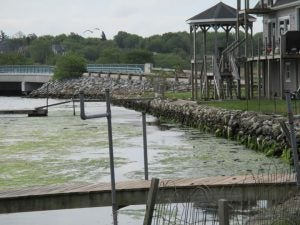Hot Topics: Cyanobacteria
What are cyanobacteria?
Cyanobacteria (also known as blue-green algae) are naturally found in many freshwater systems. “Blooms” of excess cyanobacteria occur in waterbodies when excess nutrients, sunlight, and high temperatures create perfect conditions, most often in late summer to early fall.
What’s the problem?
These blooms are unsightly, often looking like thick, bright green or blue-green foam or scums on the surface or even like pea soup. Many cyanobacteria produce toxins dangerous to humans, pets, and wildlife. Laboratory tests are needed to confirm if toxics are present.
What are the potential impacts?
Skin irritations, illness, loss of plant and animal life, loss of aesthetic appeal, loss of recreational opportunities, and even reduction in property values. If a cyanobacteria bloom is observed, take caution and stay out of the water to avoid potential exposure to toxins. Keep pets away too.
How can I help?
URI WW encourages you to report blooms to RI DEM;
email: DEM.OWRCyano@dem.ri.gov or call 401-222-4700.
In addition, you may choose to participate in the Cyanobacteria Monitoring Collaborative. This effort, which URI WW participates in, is a partnership between EPA, UNH Extension, and citizens to better understand cyanobacteria blooms and to hopefully be able to forecast them eventually. Two ways to participate:
- Through BLOOMWATCH, you can report cyanobacteria blooms on the “bloomWatch” app on your smart phone. You will help officials and organizations understand where and when these organisms may be causing issues
- Through CYANOSCOPE, you get trained as a citizen scientist. For this you need additional training on how to sample and prepare slides. Equipment is also required.
- Learn more about programs BLOOMWATCH AND CYANOSCOPE at https://cyanos.org/
Learn more about cyanobacteria – review the RI DEM Fact Sheet on Cyanobacteria.
